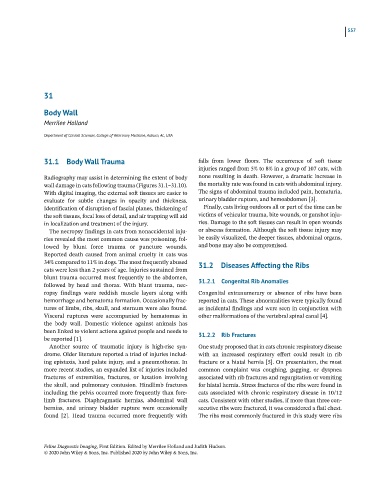Page 544 - Feline diagnostic imaging
P. 544
557
31
Body Wall
Merrilee Holland
Department of Clinical Sciences, College of Veterinary Medicine, Auburn, AL, USA
31.1 Body Wall Trauma falls from lower floors. The occurrence of soft tissue
injuries ranged from 5% to 8% in a group of 107 cats, with
Radiography may assist in determining the extent of body none resulting in death. However, a dramatic increase in
wall damage in cats following trauma (Figures 31.1–31.10). the mortality rate was found in cats with abdominal injury.
With digital imaging, the external soft tissues are easier to The signs of abdominal trauma included pain, hematuria,
evaluate for subtle changes in opacity and thickness. urinary bladder rupture, and hemoabdomen [3].
Identification of disruption of fascial planes, thickening of Finally, cats living outdoors all or part of the time can be
the soft tissues, focal loss of detail, and air trapping will aid victims of vehicular trauma, bite wounds, or gunshot inju-
in localization and treatment of the injury. ries. Damage to the soft tissues can result in open wounds
The necropsy findings in cats from nonaccidental inju- or abscess formation. Although the soft tissue injury may
ries revealed the most common cause was poisoning, fol- be easily visualized, the deeper tissues, abdominal organs,
lowed by blunt force trauma or puncture wounds. and bone may also be compromised.
Reported death caused from animal cruelty in cats was
34% compared to 11% in dogs. The most frequently abused 31.2 Diseases Affecting the Ribs
cats were less than 2 years of age. Injuries sustained from
blunt trauma occurred most frequently to the abdomen,
followed by head and thorax. With blunt trauma, nec- 31.2.1 Congenital Rib Anomalies
ropsy findings were reddish muscle layers along with Congenital extranumerary or absence of ribs have been
hemorrhage and hematoma formation. Occasionally frac- reported in cats. These abnormalities were typically found
tures of limbs, ribs, skull, and sternum were also found. as incidental findings and were seen in conjunction with
Visceral ruptures were accompanied by hematomas in other malformations of the vertebral spinal canal [4].
the body wall. Domestic violence against animals has
been linked to violent actions against people and needs to 31.2.2 Rib Fractures
be reported [1].
Another source of traumatic injury is high-rise syn- One study proposed that in cats chronic respiratory disease
drome. Older literature reported a triad of injuries includ- with an increased respiratory effort could result in rib
ing epistaxis, hard palate injury, and a pneumothorax. In fracture or a hiatal hernia [5]. On presentation, the most
more recent studies, an expanded list of injuries included common complaint was coughing, gagging, or dyspnea
fractures of extremities, fractures, or luxation involving associated with rib fractures and regurgitation or vomiting
the skull, and pulmonary contusion. Hindlimb fractures for hiatal hernia. Stress fractures of the ribs were found in
including the pelvis occurred more frequently than fore- cats associated with chronic respiratory disease in 10/12
limb fractures. Diaphragmatic hernias, abdominal wall cats. Consistent with other studies, if more than three con-
hernias, and urinary bladder rupture were occasionally secutive ribs were fractured, it was considered a flail chest.
found [2]. Head trauma occurred more frequently with The ribs most commonly fractured in this study were ribs
Feline Diagnostic Imaging, First Edition. Edited by Merrilee Holland and Judith Hudson.
© 2020 John Wiley & Sons, Inc. Published 2020 by John Wiley & Sons, Inc.

